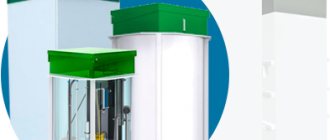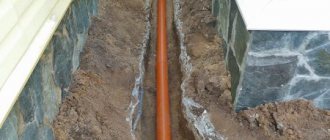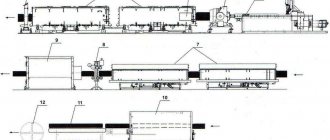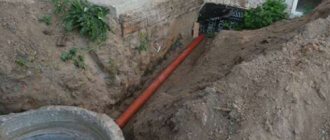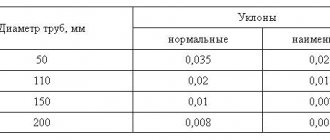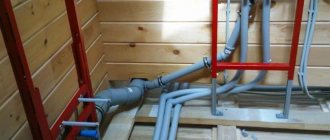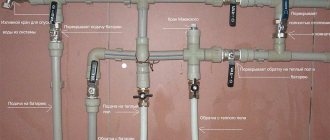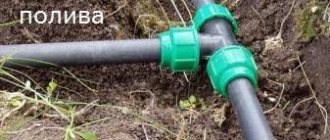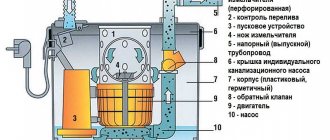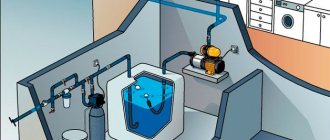Factors that influence the choice of diameter
It is not difficult to determine what factors influence the diameter of the pipe.
Water pipes
Among others, the following can be highlighted:
- Pipeline length;
- Water pressure;
- Its consumption per unit of time.
So, if we take into account the water pressure, then there is only one condition - the lower it is, the larger the diameter should be. In the case where the pressure is strong and the diameter is small, water will flow, creating noise. If the diameter is small and the pressure is also small, then the water will “ooze” and not flow.
As for the length of the water pipe in a private house or apartment, there is a special formula that shows the relationship between the thickness of the material and its length. Without going into these numbers, we can say the following:
- When the length is no more than 30 meters, then pipes up to 20 mm can be used;
- If the length is more than 30 meters, then a section of 25 or 32 mm or more is used;
- In the case when the length is very short, about 10 m, then pipes with a cross section of 10 mm are used.
Wall thickness and its effect on other parameters
Before designing a system, it is necessary to determine what diameter (abbreviated Ø) is required. There are complex hydraulic calculations that only real professionals can handle.
These calculations are necessary to select the correct dimensions for all sections of the water supply system and save on possible costs. The location of the system, internal pressure - these parameters require special attention.
Large sections are not superfluous, but they are more expensive than other options.
In what diameter are polypropylene pipes produced for water supply? It is in the range of 16-1200 mm. Each size has its own purpose.
- 16-32 millimeters are the optimal parameters for heating systems in domestic conditions.
- 40-50 millimeters - for sewerage with internal installation. In this case, installation of pipes of 110 mm is allowed.
The number of points responsible for water supply and the length of the pipeline determine the choice of size for those involved in designing the internal system through which cold water flows.
32 millimeters is the minimum size for water supply of a polypropylene supply pipe. The diameter should be within 16-20 millimeters if we are talking about indoor wiring. This applies to the external indicator.
How is diameter designated and translation systems?
You need to know the systems for calculating pipe sizes, at least so that you can correctly connect, for example, plastic pipes with copper.
The thing is that metal pipes have different calculation systems:
- Copper and aluminum are measured using metric standards;
- Steel products are calculated according to imperial standards.
The imperial number system is also used in the production of plastic products.
So, the following table will help convert data from one number system to another:
| Inches | Millimeters |
| 1/2 | 12.7 |
| 3/4 | 19 |
| 7/8 | 22.2 |
| 1 | 25.4 |
| 1.5 | 38.1 |
| 2 | 50.8 |
There is one more feature here. The designation of materials for plumbing in a private house or apartment differs from generally accepted standards. For example, a half-inch pipe is made with a diameter less than 21 mm. The external thread has exactly the same diameter. However, it is designated differently - in accordance with its internal diameter. In practice, such a notation will have an additional word at the end of “pipes”, that is, 1/2″ pipes.
Therefore, the above values are only suitable for plumbing steel products. For threaded connections the following table is used:
| Inches | Millimeters |
| 1/2 | 20.7 |
| 3/4 | 26.2 |
| 7/8 | 30 |
| 1 | 33 |
| 1.5 | 46.2 |
| 2 | 58.3 |
What else does the calculation of cross-country ability depend on?
The outer diameters do not play a special role. Passability is determined:
- Because there are so many turns and places where one size goes into another.
- Deposits and age indicators.
- Properties of the product. On a flat surface the speed will be greater.
- Pipeline length. The resistance that slows down the movement of water increases with increasing length.
- Systemic pressure.
- Internal section. A polypropylene pipe, the internal diameter of which is calculated separately, is no exception.
Video: table of diameters in video format
Selecting the required size
As already noted, the required size can be calculated using various formulas that will take into account both the water pressure in the water supply system and its consumption in a private house or apartment. However, in practice, no one uses such complex calculations for indoor wiring. Usually everything happens much simpler:
- For the main wiring, products with sizes of 10 and 15 mm (1/2 inch) are purchased;
- For risers, purchase products with dimensions of 25 mm (1 inch) or 20 mm (3/4 inch).
Pipe routing
However, there are still problems here. This is due to the fact that the outer diameter is always indicated. The internal one can be calculated by subtracting two wall thicknesses. This is exactly the rub - it varies from manufacturer to manufacturer. Therefore, for example, the internal hole can have a size from 11 to 13 mm (for a half-inch pipe), and from 21 to 23 (for an inch pipe). Moreover, this is typical for both plastic plumbing products and metal ones.
Which water supply pipes are best to choose from polyethylene?
Polyethylene pipes also come in different types. The indicated marking indicates their difference from each other. For example, SDR 11 or PE 80 SDR 21.
The SDR indicator indicates the ratio of the outer diameter and wall thickness of the pipe. The higher this indicator, the thinner the wall, and vice versa.
There are different materials from which polyethylene pipes are made:
- PE 100 – polyethylene with a crystal lattice structure. Its welding allows you to make a strong, even and smooth seam.
- PE 80 can be joined at lower temperatures.
- The PE 100 marking indicates greater strength and wear resistance of the material.
- PE 80 is quite uneconomical, because the production of pipes of the required diameter requires a larger amount of this polyethylene.
To choose the right polyethylene pipes, you should consider the following features of products made from such materials.
PE 80 SDR 21
Such pipes can withstand only low pressure. They are completely unsuitable for high pressure. They can be used for low-pressure sewers and cold water supply. The walls of such pipes are very thin, so there is no need to use them for gas pipelines and laying highways.
PE 80 SDR 17
The SDR 17 marking indicates an average ratio of diameter to wall thickness. PE 80 SDR 17 are suitable for various communications. They are mainly used for:
- Installation of water supply systems supplying drinking water;
- Water pipelines for household purposes;
- Construction of an irrigation system.
Such pipes are ideal for use in low-rise buildings. These products are durable, lightweight and relatively inexpensive.
PE 80 SDR 13.6
Such products are only suitable for use at low pressure, for example, for supplying cold drinking water.
At the same time, the grade of polyethylene PE 80 has been improved. The purification of raw materials is carried out using a new method. In this regard, these pipes are of good quality. The warranty period reaches 70 years. Accordingly, they are strong and durable.
PE 100 SDR 26
Polyethylene PE 100 is denser. This means that the pipes are stronger and have a longer service life. They are well suited for domestic and drinking water in urban and suburban environments. Due to quality indicators, the wall thickness is reduced. Accordingly, the pipes became lighter.
PE 100 is suitable for use:
- When installing water supply;
- In the food industry, for example for transporting dairy products and drinks.
PE 100 SDR 21
Such pipes are of good quality material; therefore, they do not affect the taste of liquids and do not add odors. Therefore, they are excellent for installing water pipes. In addition, PE 100 SDR 21 pipes are equipped with plastic and metal adapters at the ends, which makes it possible to use them together with other types of pipes. Corrosion and blockages do not affect such a product.
PE 100 SDR 17
Such pipes are new developments of polyethylene. This material is especially durable and wear-resistant, and has high performance indicators.
They can be used for water and gas supply, for installation of communications with a large cross-section. Due to such high rates, it is possible to reduce such a parameter as the thickness of the walls. Strength will not be affected by this. But the pipe will become lighter and cheaper in price. This is an excellent option for long-distance water pipes.
PE 100 SDR 11
For the manufacture of such pipes, polyethylene obtained at low pressure is used. PE 100 SDR 11 pipes are characterized by the high density of the material used, so they are well suited for high-pressure water pipes. The material is high quality and environmentally friendly.
These pipes have the most advanced capabilities. They are used for both water supply and wastewater disposal. They are excellent for sewer installation, being resistant to chemical influences and generally durable.
Approximate calculation
To calculate the diameter of the pipe for the water supply of a private house or apartment, you need to know some a priori data. For example, water flow, pressure, number of bends, and so on.
However, as mentioned earlier, no one ever makes such complex calculations, especially when it comes to a private house.
So, it has been experimentally established that the normal flow from a conventional mixer is considered to be one that produces approximately ¼ liter per second. Let's take this figure as standard consumption.
As for the pressure in water pipes, in apartment buildings it can fluctuate in a wide range from 1 to 6 atmospheres. Therefore, we will take an average pressure of 2 bar.
Based on this, we obtain the following initial data:
- Pressure 2 bar;
- Flow rate 0.25 l/s;
- The length of plumbing products is 10 meters;
- Let's assume that metal-plastic material with a size of 16 mm (standard size for plastic pipes) will be used.
From here we immediately know that the internal diameter will be approximately 12 mm, since the walls are 2 mm.
Plumbing of a private house
So, first we determine the flow rate in the water supply elements. To do this we apply the formula:
V=(4*Q)/(π*D2), in which:
- Q is the fluid flow rate, expressed in cubic meters per second (in our case it is 0.00025);
- D – internal diameter, expressed in meters (0.012 m);
- P – constant 3.14.
Substituting these values, we get: 4*0.00025/3.14*0.012*0.012 = 2.21 m/s.
The next step is to find the Reynolds number using the formula:
Re = V*D/v, where v is the table value for a temperature of 16 degrees.
Substituting the already known values, we get 22882.
Next, you need to look at the table in which you need to find the formula for hydraulic friction. Let's assume that we need a formula from the first area:
Lyabda = 0.3164/Re to the 0.25 power, substituting the values into it, we get 0.0257.
The next step is to find out the head loss. This is done according to the formula:
h=λ*(L*V2)/(D*2*g) , where:
- H – losses;
- L – pipeline length;
- g is the acceleration of gravity, that is, 9.81 m/s squared;
- V – flow velocity;
- D – diameter.
Substituting all the values, we get the number 5.34 m.
All that remains is to analyze the result obtained. So, we assumed a pressure of 2 bar, which corresponds to 20 meters of pressure. The result was 5.34 meters, which is less than 20, which means that the selected diameter is suitable, and with a margin.
In any other case, when this figure would be larger, it is necessary to increase the size of the selected material.
Brief conclusion
So, it is clear that the choice of the required size depends on many parameters, on the flow of water, on the amount consumed, on some properties of the products themselves. The calculation of the optimal value, in its entirety, links all these parameters together, that is, it must take all of them into account. However, for home plumbing, the above option is quite sufficient.
Since pressure losses are largely due to the presence of different angles, tees and similar elements in the system. To take this factor into account, as practice shows, you just need to add another 10% to the final number. It must also be said that the same 10% should also be added to all other factors that were not taken into account in the calculations.
Summing up
The diameter of the pipes is a very important parameter when laying a water pipeline. Inconsistency between values may result in system failure or malfunction. To avoid this, all calculations should be made accurately, without deviating from the values in the tables and strictly following the formulas.
Many modern construction companies not only lay pipelines themselves, but also carry out a full calculation of the system. These professionals are armed with the latest software developments that not only simplify the design process, but also make the final result more accurate. But, if desired, you can calculate the diameter of the pipeline yourself, just follow the recommendations exactly.
Water in a private house
| Author | Share | Rate |
| Victor Samolin |
Interesting on the topic:
Soldering polypropylene pipes with your own hands
How to choose pipes for water supply in a private house
All about water pressure in the home plumbing system
Comments on this article
Igor Tell me, what should be the diameter of the pipes of an apartment building if the pressure is 6 atmospheres?
It is planned to install metal-plastic pipes. 04/04/2016 at 15:10Dmitriy Please tell me! For a house with three floors there will be 3 bathrooms + a kitchen and irrigation! They installed a 20 pipe in my house, the pressure in the main line is 5 bar from the main line to the house 30 meters! Will the pressure be good in the house? or not and why 07/05/2016 at 00:30
Vladimir Please tell me! One-story house, 3/4 supply to the meter, 1/2 meter and then 1/2 everywhere else. For watering the garden, a 1/2 hose 40 m long, since this is a private sector, the pressure is weak in the summer. It makes sense to change everything that I have 1/2 (and even the counter) to 3/4. Will the pressure be stronger? 06/27/2017 at 22:31
